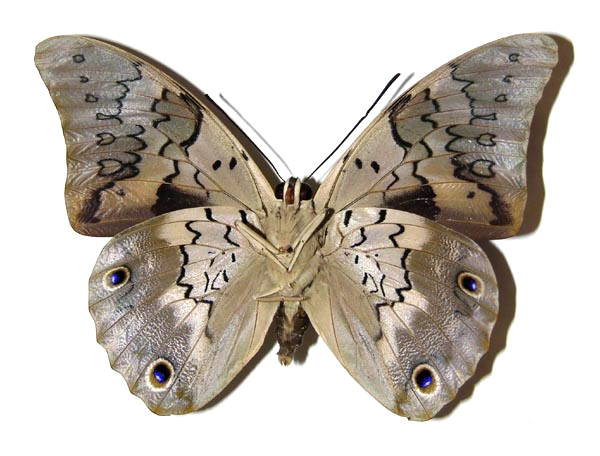Butterfly Mimicry
Prepona demodice Butterfly
Costa Rica
From the researcher's perspective...
Everyone who has put out a butterfly trap baited with fermenting bananas in ACG forest knows Prepona laertes, with its striking false eye spots on the underside (and even a remnant of eye spot on the brown upperside, with its two gaudy iridescent multi-blue stripes). The smallest of the ACG five known species in the Prepona-Archaeoprepona cluster of charaxine nymphalids, it is present in any lowland habitat that still has trees and an understory. And it ranges from tropical Mexico to Venezuela and Peru, at least—though the variety of subspecific names that have been applied to it over this range suggest more than the usual inclination of lepidopterists to baptize each morph of a spectacular butterfly with its own scientific handle. There is no hint of mystery in the silvery-to-beige underside with a complex pattern of what are meant to look like crevice margins in the tree bark that it commonly sits on while probing and sucking with its pink tongue in a yeast- and ferment-filled wound.
However, all is not as it seems. The first clue was finding that the leaf-mimic caterpillar feeds on Hirtella racemosa and Licania arborea in the Chrysobalanaceae, and on six species of Fabaceae (Inga, Zygia, Andira). There is no other species of ACG caterpillar that feeds on just these two sets of food plants, plants that are not at all taxonomically closely related, and not known to be similar in their defensive chemistry. Then a perceptive South American lepidopterist, whose email got sucked up by the ether so we cannot thank him or confirm, wrote that he thought that some detail of color of the upperside of the P. laertes specimens shown on the web site suggests that there might be two species there. And then we DNA barcoded the ACG specimens and surprise, surprise, what we call P. laertes in ACG is definitely two biological entities, one feeding on Chrysobalanaceae and one feeding on Fabaceae. They are fully sympatric and we do not know at the time of this writing whether the male we illustrate is the “true” P. laertes. Equally, we have no idea if the seemingly single widespread P. laertes is one or more species.
Daniel Janzen
DNA Barcode of Prepona demodice
Accessed from Barcode of Life Data Systems
MHAAC004-06 | 03-SRNP-1747 | Porphyrogenes laertes | COI-5P
AACTTTATATTTTATTTTTGGTATTTGAGCAGGAATAGTAGGAACTTCCCTCAGTCTTATTATTCGAACAGAATT AGGAAACCCAGGATTTTTAATTGGAGATGATCAAATTTATAATACTATTGTCACAGCCCATGCTTTTATCATAAT TTTTTTTATAGTTATACCTATTATAATTGGAGGTTTTGGTAATTGATTAGTCCCTCTTATATTAGGAGCCCCAGA TATAGCTTTCCCCCGAATAAATAATATAAGTTTCTGGCTTTTACCCCCCTCTTTAATACTTTTAATTTTCAGAAG AATTGTAGAAAATGGAGCCGGTACTGGATGAACAGTGTACCCCCCACTATCATCAAATATTGCCCATGGTGGAGC ATCGGTAGATTTAGCTATTTTTTCTCTTCATTTAGCAGGTATTTCTTCTATTCTTGGAGCAATTAATTTCATTAC TACAATTATTAATATACGAATTAATAGTATAAACTATGATCAAATACCATTATTTGTTTGATCAGTAGGTATTAC CGCTTTACTTTTATTGCTTTCTCTTCCAGTATTAGCAGGCGCTATTACAATGTTATTAACAGATCGAAATTTAAA TACATCATTTTTTGATCCTGCCGGAGGAGGTGATCCAATTCTATACCAACATTTATTT


